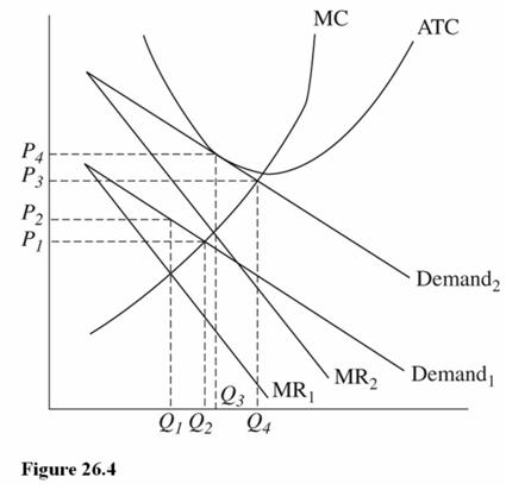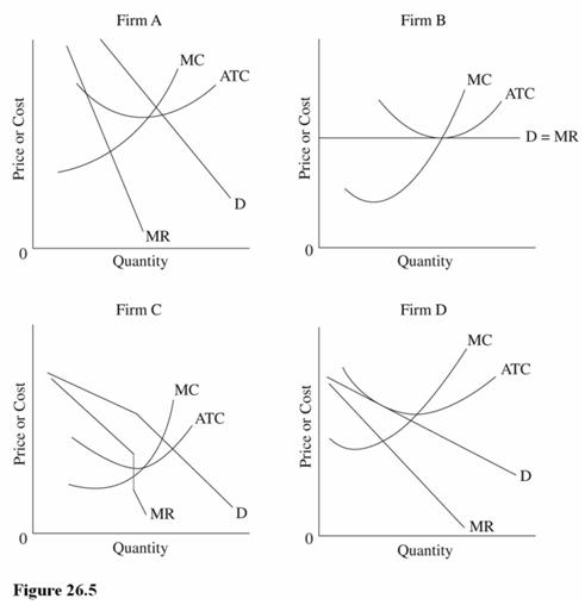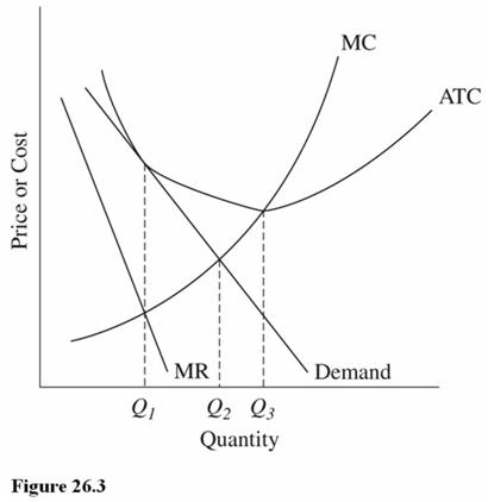A) Is less than price.
B) Equals price.
C) Is greater than price.
D) Equals average total cost.
Correct Answer

verified
Correct Answer
verified
Multiple Choice
Entry into a market characterized by monopolistic competition is generally
A) Entirely blocked by existing firms.
B) Very easy because few barriers exist.
C) As difficult as in oligopoly.
D) More difficult than entry into monopolized markets.
Correct Answer

verified
Correct Answer
verified
Multiple Choice
The competitive dimension of monopolistic competition is that
A) High barriers to entry tend to push economic profits toward zero.
B) Consumers view each firm's products as interchangeable.
C) Low barriers to entry tend to push economic profits toward zero.
D) Each firm in the industry will lose all of its customers if it raises its price.
Correct Answer

verified
Correct Answer
verified
True/False
For a monopolistically competitive firm, barriers to entry are high, which allows the firm to earn positive economic profits in the long run.
Correct Answer

verified
Correct Answer
verified
True/False
A monopolistically competitive firm that runs a successful advertising campaign creates enormous goodwill, but this goodwill does little to increase the value of the company.
Correct Answer

verified
Correct Answer
verified
Multiple Choice
 Refer to Figure 26.4 for a monopolistically competitive firm.In the long run this firm will charge a price of
________ and produce an output of _______.
Refer to Figure 26.4 for a monopolistically competitive firm.In the long run this firm will charge a price of
________ and produce an output of _______.
A) P2; Q1
B) P4; Q3
C) P1; Q2
Correct Answer

verified
Correct Answer
verified
Multiple Choice
A World View article titled "The Best Global Brands" discusses the value of brand names.In 2014 which of the following was the most valuable brand name?
A) Apple.
B) Google.
C) Coca-Cola.
D) McDonalds.
Correct Answer

verified
Correct Answer
verified
Multiple Choice
Which of the following market structures will have only normal profit in the long run?
A) Monopoly.
B) Duopoly.
C) Monopolistic competition.
D) Oligopoly.
Correct Answer

verified
Correct Answer
verified
True/False
If a monopolistic competitor lowers its price, it will attract a significant number of new customers.
Correct Answer

verified
Correct Answer
verified
Multiple Choice
 Which firm in Figure 26.5 is most likely a monopolistically competitive firm in the long run?
Which firm in Figure 26.5 is most likely a monopolistically competitive firm in the long run?
A) Firm C.
B) Firm A.
C) Firm D.
D) Firm B.
Correct Answer

verified
Correct Answer
verified
Multiple Choice
One of the main differences between an oligopoly and a monopolistically competitive firm is that a monopolistically competitive firm
A) Faces a horizontal demand curve; an oligopoly does not.
B) Is relatively independent; an oligopoly is interdependent.
C) Has no market power; an oligopoly has some market power.
D) Has high barriers to entry; an oligopoly does not.
Correct Answer

verified
Correct Answer
verified
Multiple Choice
Demand and Cost Data for Will's Beach Ball Company
| Price | Demand Data Quantity | Cost Data Output | Total Cost |
|---|---|---|---|
| $11 | 6 | 6 | $48 |
| $10 | 7 | 7 | $52 |
| $9 | 8 | 8 | $57 |
| $8 | 9 | 9 | $63 |
| $7 | 10 | 10 | $70 |
A) 6; $22
B) 7; $20
C) 8; $18
D) 9; $16
Correct Answer

verified
Correct Answer
verified
True/False
In monopolistic competition, modest changes in the output or price of any single firm will have no significant influence on the sales of other firms.
Correct Answer

verified
Correct Answer
verified
Multiple Choice
 Refer to Figure 26.3 for a monopolistically competitive firm.The allocatively efficient output for this firm is
Refer to Figure 26.3 for a monopolistically competitive firm.The allocatively efficient output for this firm is
A) Q1.
B) Q2.
C) Q3.
D) Zero. The firm should shut down because it is not earning an economic profit.
Correct Answer

verified
Correct Answer
verified
Multiple Choice
Monopolistically competitive industries are characterized by all of the following except
A) Homogenous products.
B) Low entry barriers.
C) Low concentration ratios.
D) Independent production decisions.
Correct Answer

verified
Correct Answer
verified
Multiple Choice
The main difference between perfect competition and monopolistic competition is
A) The degree of product differentiation.
B) The long-run economic profits that are expected.
C) The number of firms in the market.
D) The ease of entry and exit.
Correct Answer

verified
Correct Answer
verified
Multiple Choice
Product differentiation refers to
A) Features that make one product appear different from competing products in the same market.
B) Different prices for the same product in a certain market.
C) The selling of identical products in different markets.
D) The charging of different prices for the same product in different markets.
Correct Answer

verified
Correct Answer
verified
True/False
The monopolistically competitive firm earns zero economic profit in the long run.
Correct Answer

verified
Correct Answer
verified
Multiple Choice
A monopolistically competitive firm can raise its price somewhat without fear of great change in unit sales because
A) The demand for its product is typically very price-elastic.
B) Its demand curve is horizontal.
C) Of product differentiation and brand loyalty.
D) Of the gap in its marginal revenue curve.
Correct Answer

verified
Correct Answer
verified
Multiple Choice
An In the News article titled "Selling "Pure Water": A $Billion Scam?" refers to the use of advertising.Successful advertising can do all of the following except
A) Differentiate products.
B) Create brand loyalty.
C) Decrease the price elasticity of demand for the product.
D) Maximize efficiency.
Correct Answer

verified
Correct Answer
verified
Showing 41 - 60 of 150
Related Exams